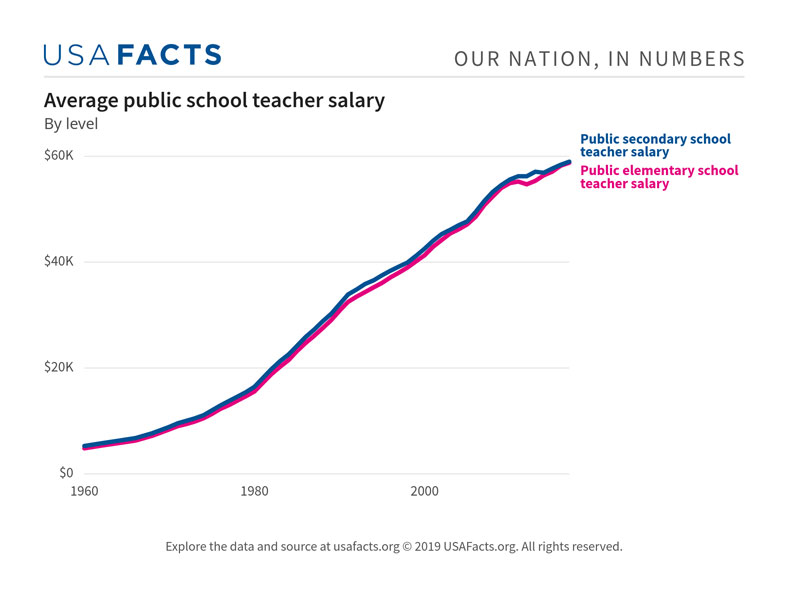Side Hustles for Teachers
8/2/2023

For those working in education, money is rarely the primary motivation. Worldwide, teachers are underpaid and are driven by passion and dedication to their students. In spite of this commendable effort, most people need additional income to support themselves and their families.
It can be sobering for some who are considering entering the teaching profession to learn that on top of the immense responsibilities of the job, they may be required to take on additional work.
Fortunately, working teachers have already paved the way to help newcomers to the field find lucrative and accessible opportunities to earn more money without creating a significant disruption to their primary teaching careers.
Read on to discover some of the best side hustles for teachers, as well as information about teacher salaries and financial considerations.
How Are Teacher Salaries Determined?
When it comes to teacher salaries, several factors come into play. Education level and experience significantly impact average salaries. Teachers with higher degrees and extensive teaching experience tend to earn higher incomes. Moreover, geographical location plays a crucial role in determining salary disparities. Certain areas offer higher compensation due to factors such as cost of living and demand for teachers. To shed more light on this, the following infographic provides a visual representation of average teacher salaries across different locations.

Indeed, the Bureau of Labor Statistics reports that elementary, middle, and high school teachers earn mean annual wages between $67,790 and $69,480 per year. These numbers can go up considerably with experience - those in the 90th percentile of high school teachers can earn an average of $101,710 per year - but these are not starting salaries, and they are not necessarily what will be offered by every academic institution.
However, it's important to note that teacher salaries are not the only form of compensation. Teaching positions often come with a range of benefits and perks. These can include healthcare coverage, retirement plans, professional development opportunities, and paid leave, among others. Such benefits add value to the overall compensation package and contribute to a satisfying career.
For educators looking to supplement their income, side hustles can be a viable option.
Embracing side hustles for teachers during the summer break allows them to continue their professional growth while exploring different avenues.
Whether it's tutoring, freelance writing, or starting a small business, these endeavors can provide additional income and fulfillment outside the classroom. The summer break serves as a valuable time to engage in side hustles, further enhancing financial stability and personal growth.
10 Side Jobs for Teachers: Supplementing Income and Diversifying Skills
The hard work and passion of most educators do not always match their paycheck. Although teaching is a rewarding profession, many teachers are underpaid and have difficulty staying afloat. Here are 10 side hustles for teachers interested in broadening their interests and enhancing their incomes.

1. Tutoring and Academic Coaching
Academic coaching and tutoring are among the most popular teaching-related side hustles. A wide variety of avenues and resources are available, ranging from in-person and online sessions to standardized test preparation.
An example of a popular tutoring service is ESL, or English as a second language. As this opportunity can be conducted virtually or in person during the summer months, it is suitable for educators of all levels. You will have the opportunity to test your travel abilities while making money, and you will also have the opportunity to build relationships with students around the world. Teachers of all backgrounds can use tutoring and coaching to supplement their income, regardless of their fields of expertise.
2. Curriculum Development and Lesson Planning
Lesson plans are not easy to create, but they are necessary for every teacher. Unfortunately, not every teacher has the time, energy, or creativity to accomplish this. If you've already mastered lesson planning, this is the perfect side hustle. With platforms like TeachersPayTeachers, you can sell curriculums, worksheets, assessments, and other educational materials. Simply share your best work on the site and get paid.
You can also sell through platforms like Etsy or create your own website. You'll not only earn extra money when someone buys one of your course materials, but you'll also help other overworked teachers prepare for the new academic year.
3. Online Teaching and Course Creation

Online teaching and course creation make for an ideal side hustle for teachers. Selling your teaching materials and lesson plans online can provide both additional income and help fellow educators seeking innovative teaching methods. Platforms like Udemy enable you to design tailored lesson plans in your subject area while offering the flexibility to create your own schedule.
The demand for online learning is on the rise, presenting a lucrative market for educators to share their expertise and generate revenue. (See more on this below.) Embrace online teaching and course creation as a rewarding side hustle, allowing you to share knowledge, support colleagues, and earn extra income, all while enjoying the freedom to work on your own terms.
4. Freelance Writing and Content Creation
Freelance writing and content creation offer teachers a quick and enjoyable way to earn extra income, regardless of their subject expertise. Job boards like x and x provide a variety of freelance opportunities, making it accessible for teachers to find work. Payment systems are user-friendly, and the range of freelance gigs is extensive.
Content creation extends beyond writing, as teachers with intermediate computer skills and a passion for photography can sell stock photos, create blogs, or contribute to platforms like Canva. With endless possibilities, content creation and freelancing can be a fun and fulfilling side hustle for teachers looking to supplement their income.
5. Educational Consulting and Professional Development
Educational consulting and professional development present enticing side hustle opportunities for teachers, especially as more parents opt for homeschooling. Serving as a part-time or freelance homeschool consultant, educators can make a significant impact on students' education. They take charge of monitoring progress, addressing concerns, and providing recommendations for social activities, while also supporting parents in their dual roles as teachers and caregivers.
Whether starting their own consultancy locally or online or joining an established homeschooling organization, teachers can embark on this flexible and rewarding side hustle. By sharing their expertise, they contribute to the homeschooling community and make a positive difference in students' lives.
6. Arts and Crafts, Etsy, and Handmade Goods
For educators seeking to supplement their income, exploring side hustles such as starting an Etsy shop can prove to be a rewarding endeavor. If you possess a talent for crafting and moderate computer skills, Etsy provides an ideal platform to showcase your creations. With a myriad of categories available, finding a niche that aligns with your favorite arts and crafts hobby is easily achievable. The process of creating a listing on Etsy is remarkably straightforward, requiring just a few captivating photos and a description.
What's more, the cost-effectiveness of publishing a listing, starting from as little as 75 cents, makes it an accessible option. Furthermore, transitioning your Etsy shop into a summer job grants you the opportunity to continue nurturing your creative passions during the break, fostering both personal fulfillment and financial stability.
7. Coaching and Extracurricular Activities

For educators seeking to maintain an active lifestyle, engaging in sports or leveraging their experience in playing them, coaching a sports team emerges as a remarkable side hustle. Opportunities to assume coaching positions abound, spanning across school districts, local recreation departments, and private sports clubs.
The role of a coach offers a fulfilling adjunct job, enabling the establishment of strong bonds with athletes and fostering their skill development. Likewise, embracing the role of a swim instructor or lifeguard serves as an alternative side hustle for teachers. Numerous avenues exist, including local recreation departments, private swimming clubs, and community pools.
Additionally, providing private swimming lessons within the community presents an appealing prospect. These roles also transition seamlessly into summer jobs, allowing teachers to continue their involvement in sports while enjoying the break.
8. Summer Jobs and Camp Counseling
Summer jobs and camp counseling are exceptional side hustle options for teachers, offering a perfect blend of enjoyment, engagement, and supplementary income during the summer break. Many schools provide summer programs to help students catch up or get ahead academically, making teaching summer school a viable opportunity found within your district or school. This experience not only allows you to earn extra income but also fosters stronger connections with your students.
Additionally, becoming a camp counselor is an excellent option as camps are typically held during the summer months. It provides an opportunity to stay active, connect with nature, and engage with children in a unique and fulfilling way. You can explore camp counselor positions through your school district, private organizations, or online job boards, ensuring you find the perfect fit for your preferences and schedule. Embrace these summer side hustles to continue making a positive impact on young minds while relishing the vibrant and refreshing summer atmosphere.
9. Real Estate and Property Management
Apps and services like Airbnb have grown in popularity over the years. So, if you have a spare room or apartment, consider renting it out for long-term or short-term stays. You'll only need to set the dates and maintain a clean and welcoming space for your guests. But, of course, you'll also have to ensure your insurance is up-to-date to cover any potential losses. As an Airbnb host, you can make up to $924 a month.
There is a growing demand for unique, affordable travel accommodations, and many people would rather stay with a local host than in a hotel. Becoming an Airbnb host is a popular side hustle for teachers because it can provide substantial supplemental income. In fact, in 2019, Airbnb reported that 10% of their hosts were teachers and earned $230 million.
In 2022, Airbnb partnered with the National Education Association (NEA) to help support teachers' hosting endeavors. They offer lessons on creating great home listings, a stipend for investing in your rental, and other special privileges.
Being an Airbnb can have tremendous financial rewards and allow you to meet lots of new people from around the world.
10. Delivery and Rideshare Services

As long as you have your own car and valid insurance, ridesharing and delivery are the perfect side hustle for teachers. Depending on your area, DoorDashers can make upwards of $20 an hour. You'll have to factor in mileage and gas, but various platforms like x and x help you to keep track and deduct from your pay accordingly for tax time. Grocery shopping can be a pain, so apps like x make it possible to go grocery shopping for others and earn money. These are great side hustles for teachers because they fit into your schedule with flexible hours and can even be done during lunch breaks.
Balancing Teaching and Side Jobs: Tips and Strategies
Managing a teaching career alongside side jobs requires effective strategies. This section provides valuable tips and insights on time management, leveraging skills, setting boundaries, networking, and financial planning. Discover practical advice to strike a harmonious balance, excel in both roles, and enhance your professional and financial well-being.
Time Management and Prioritization
- Create a well-structured schedule to allocate dedicated time for teaching and side jobs.
- Prioritize tasks based on urgency and importance to maintain focus and productivity.
Efficient time management and prioritization are crucial for balancing teaching and side jobs. By creating a clear schedule and prioritizing tasks effectively, educators can maximize productivity and ensure that both responsibilities receive the necessary attention.
Leveraging Skills and Expertise
- Choose a side hustle that aligns with your teaching expertise to maximize earning potential.
- Utilize your knowledge and experience to excel in your side job and enhance professional growth.
By leveraging teaching skills and expertise in a side hustle, educators can maximize their earning potential while enhancing their professional growth. Selecting a side job that aligns with their expertise allows them to apply their knowledge and experience effectively.
Establishing Boundaries and Avoiding Burnout
- Set clear boundaries between teaching and side jobs to maintain work-life balance.
- Practice effective workload management to prevent burnout and prioritize well-being.
Maintaining a healthy work-life balance is essential to prevent burnout.
By setting clear boundaries between teaching and side jobs and effectively managing their workload, educators can avoid excessive stress and prioritize their well-being.
Networking and Building Professional Relationships
- Engage in industry events and online communities to expand professional networks.
- Connect with like-minded individuals for collaborations, referrals, and growth opportunities.
Building a strong professional network outside of teaching opens doors to side job opportunities. By actively participating in industry events, joining online communities, and connecting with like-minded professionals, educators can expand their network and access potential collaborations, referrals, and growth opportunities.
Financial Planning and Budgeting
- Develop a comprehensive financial plan that incorporates teaching income and side job earnings.
- Set financial goals, track expenses, and seek advice from a financial advisor if needed.
Creating a comprehensive financial plan that considers both teaching income and side job earnings is essential. Setting clear financial goals, tracking expenses diligently, and seeking guidance from a financial advisor, if necessary, ensure financial stability and responsible decision-making.
This section provides valuable tips and strategies to help educators successfully balance teaching and side jobs. By implementing these techniques, educators can create a harmonious and fulfilling professional life that combines their passion for teaching with additional income and personal growth.
How Remote Learning Has Expanded Side Hustle Opportunities for Teachers
Anyone working in education today has seen the field transformed by recent developments in online learning, which escalated rapidly during the height of the COVID-19 pandemic and have only continued to proliferate in the years after. Once a subject of hot debate, it's now clear that online education is here to stay, offering great convenience for students and resource-efficient models for academic institutions.
For teachers in search of supplemental income, remote learning models can provide opportunities that integrate seamlessly into your schedule.
This can make all the difference in finding sustainable side work for the long haul. Take, for example, tutoring: while private tutors once typically made house visits to students, sometimes commuting far to get there, they can now simply initiate video conferences from wherever they are. Beyond the mere convenience of this, it also allows enterprising tutors to book more clients in the time that they would have spent in transit.
Side hustle opportunities related to online education include:
- Private tutoring
- Extracurricular classes and workshops, including adult education and summer programs
- Curriculum sharing
- Test proctoring
- Professional development instruction
These are excellent options for teachers who want or need to take on extra employment opportunities but want to be sure to maintain a healthy work-life balance. If you are taking the next steps to define your side hustle path, give these options serious consideration.
Pros and Cons of Pursuing Side Jobs as a Teacher
Pursuing side jobs as a teacher has its advantages and challenges that need to be considered. These are worth keeping in mind as you determine if you will need to pursue additional work and if so, what type of side job will be best suited to your skills and schedule.
Some of the greatest benefits of pursuing a side job include the following:
- Additional income to supplement teacher salary.
- Opportunity to explore personal interests and passions.
- Potential for financial security and flexibility.
Indeed, the main reason why teachers choose to take on additional work is the opportunity to supplement income. With teaching salaries sometimes falling short, having an additional income stream can provide financial stability and flexibility. Side jobs also allow teachers to pursue their personal interests and passions, leading to personal growth and fulfillment.
However, there are important factors to keep in mind when considering taking on a side hustle. These include:
- Ethical considerations when working for direct competitors.
- Impact on work-life balance and teaching commitments.
- Potential conflicts of interest.
Ethical dilemmas may arise when working for direct competitors, even in the absence of non-compete agreements. Teachers should carefully evaluate the potential conflicts of interest involved in working for businesses that directly compete with each other.
Another challenge is striking a balance between side jobs and teaching commitments. Teachers already have demanding schedules and responsibilities, and taking on additional work can impact their work-life balance. It's crucial to find a sustainable equilibrium that allows for both professional and personal fulfillment.
Despite the challenges, side jobs can contribute to professional growth and skill enhancement.
Engaging in a side hustle provides opportunities to develop new skills, expand networks, and gain valuable experiences outside the classroom.
These experiences can positively impact teaching practices and enrich the educational experience for students.
In conclusion, pursuing side jobs as a teacher offers the potential for additional income, personal growth, and flexibility. However, it's important to navigate the ethical considerations, maintain work-life balance, and manage potential conflicts of interest. By carefully weighing the pros and cons, teachers can make informed decisions about pursuing side jobs that align with their values and commitments.

FAQs
Do all teachers need to take on side hustles?
Not necessarily. Teaching is, after all, a full-time job, and one should hope to find a position that compensates them fairly for their work. Indeed, there are teaching jobs out there that can offer solid compensation, and your choice of location can also greatly determine if your teacher salary can cover all of your expenses. However, as the article above makes clear, finding an educator position that meets your complete financial needs can be difficult. This is why so many teachers take on side hustles, though many who do so manage to comfortably integrate this work into the rest of their professional schedules.
What is the job outlook for high school teachers?
According to the Bureau of Labor Statistics, job growth projections for high school teachers are solid, with an anticipated 5% expansion of the field by 2031. This is more or less in line with the average growth rate for jobs overall, and can give those entering the teaching profession confidence that they will find long-term job security.
What qualifications are needed to become a teacher?
There are many different paths to becoming an educator, requiring different degrees and certifications. Requirements for credentialing also can vary by state, so it's imperative to look into the exact guidelines for wherever you live. Many teachers enter a credentialing program - sometimes alongside a master's program - while they are already working, so that they can hit the ground running on their professional development. In order to do this, one must already hold a bachelor's degree (though it does not necessarily have to be in the field of education).
For more information about becoming a teacher, visit our guide to teaching degree and education programs here.
- AI and The Classroom - August 2, 2023
- Side Hustles for Teachers - August 2, 2023
- How to Become a Teacher Through Certification - October 10, 2022











